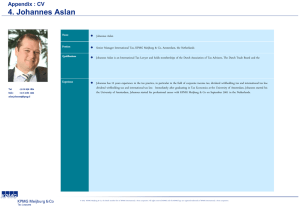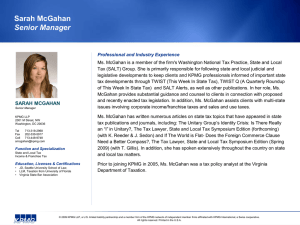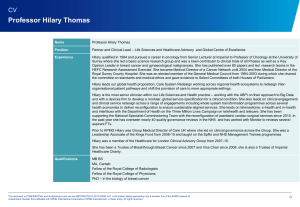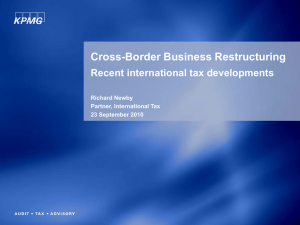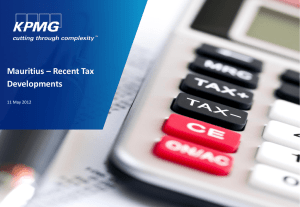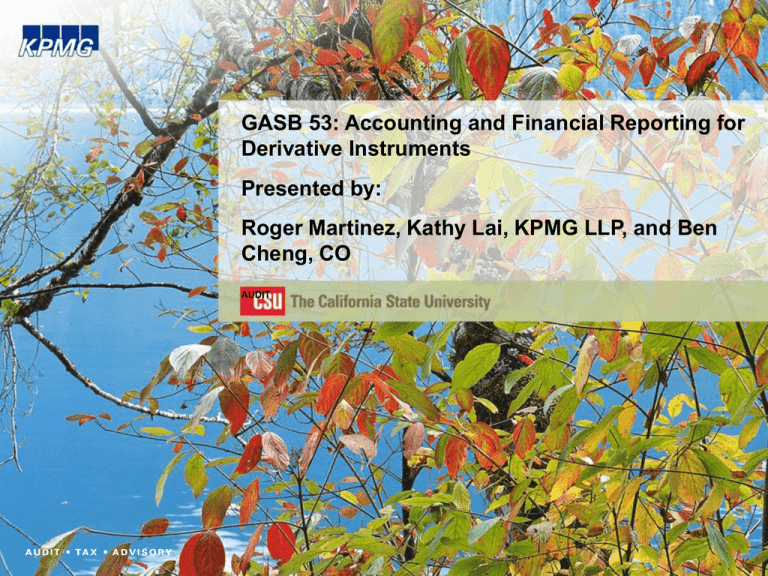
Presented by:
Roger Martinez, Kathy Lai, KPMG LLP, and Ben
Cheng, CO
AUDIT
© 2010 KPMG LLP, a Delaware limited liability partnership and the U.S. member firm of the KPMG network of independent
member firms affiliated with KPMG International Cooperative (“KPMG International”), a Swiss entity. All rights reserved. 15996ORA
GASB 53: Accounting and Financial Reporting for
Derivative Instruments
Overview of GASB Statement No. 53
Definition of a Derivative Instrument
Settlement Factors
Leverage
Net Settlement
Scope Exceptions
Hybrid Instruments
What is a Derivative
Recognition and Measurement
Deferred Inflows and Outflows
Presentation
May 2010
© 2010 KPMG LLP, a Delaware limited liability partnership and the U.S. member firm of the KPMG network of independent
member firms affiliated with KPMG International Cooperative (“KPMG International”), a Swiss entity. All rights reserved. 15996ORA
Agenda
Year-End GAAP Training
2
Miscellaneous Recognition and Measurement Items
Determining Fair Value
What is Hedging?
Types of Hedges
Association with a Hedgeable Item
What Can Be Hedgeable Items?
Overview of Hedge Effectiveness
Hedge Effectiveness Testing Methods
Other Quantitative Methods
Termination of Hedge Accounting
Disclosures for Hedging Derivative Instruments
May 2010
© 2010 KPMG LLP, a Delaware limited liability partnership and the U.S. member firm of the KPMG network of independent
member firms affiliated with KPMG International Cooperative (“KPMG International”), a Swiss entity. All rights reserved. 15996ORA
Agenda Cont.
Year-End GAAP Training
3
Effective Date and Transition
CSU Survey Results
Questions?
May 2010
© 2010 KPMG LLP, a Delaware limited liability partnership and the U.S. member firm of the KPMG network of independent
member firms affiliated with KPMG International Cooperative (“KPMG International”), a Swiss entity. All rights reserved. 15996ORA
Agenda Cont.
Year-End GAAP Training
4
© 2010 KPMG LLP, a Delaware limited liability partnership and the U.S. member firm of the KPMG network of independent
member firms affiliated with KPMG International Cooperative (“KPMG International”), a Swiss entity. All rights reserved. 15996ORA
Overview of GASB Statement 53
Statement issued in June 2008
Effective for periods beginning after June 15, 2009
Will require derivative instruments to be reported at fair value in
financial statements prepared under the economic resources
measurement focus
Reporting changes in fair value will depend on whether derivative
instrument is an effective hedge
GASB has also issued a plain-language document on derivative
instruments
May 2010
Year-End GAAP Training
5
Overview of GASB Statement 53
Certain aspects of GASB Statement 53 are conceptually similar to
FASB Statement 133, as amended:
–
Definition of a derivative instrument
–
Certain scope exceptions
–
Hedge accounting
Although conceptually similar, there are many differences in
application:
–
–
Hedge accounting required under GASB 53 if applicable
“All or nothing” approach to reporting changes in fair value using
hedge accounting
–
Use of deferred inflows and outflows
–
May 2010
Not required to quantify ineffectiveness
No other comprehensive income item
Methods of testing hedge effectiveness
© 2010 KPMG LLP, a Delaware limited liability partnership and the U.S. member firm of the KPMG network of independent
member firms affiliated with KPMG International Cooperative (“KPMG International”), a Swiss entity. All rights reserved. 15996ORA
Year-End GAAP Training
6
A derivative instrument is a financial instrument or contract that
has all of the following:
–
–
Settlement factors
One or more reference rates (underlyings)
One or more notional amounts or payment provisions or both
Leverage
–
Net settlement
May 2010
Requires little or no net investment yet responds to market changes
Contract terms require or permit net settlement
Can be readily settled net outside the contract through a market
mechanism; or
Provides for delivery of an asset that is readily convertible to cash or is
itself a derivative instrument
See also Implementation Guide
© 2010 KPMG LLP, a Delaware limited liability partnership and the U.S. member firm of the KPMG network of independent
member firms affiliated with KPMG International Cooperative (“KPMG International”), a Swiss entity. All rights reserved. 15996ORA
Definition of a Derivative Instrument
Year-End GAAP Training
7
7
Settlement Factors
Reference Rates
–
Reference rate can be any variable with changes that are
observable or otherwise objectively verifiable (cannot be the
asset or liability itself)
–
Value of a derivative instrument generally changes by direct
reference to changes in the reference rate
Notional Amount
–
The number of units specified in a derivative contract (e.g.
currency, shares, etc):
–
Amount applied to change in reference rate to determine
settlement
Payment Provisions
–
Fixed or determinable payment made if an underlying changes in
a specified manner (e.g. payment if commodity price increases
10%)
–
Often included in lieu of a notional amount
May 2010
© 2010 KPMG LLP, a Delaware limited liability partnership and the U.S. member firm of the KPMG network of independent
member firms affiliated with KPMG International Cooperative (“KPMG International”), a Swiss entity. All rights reserved. 15996ORA
Year-End GAAP Training
8
No initial net investment or smaller initial investment than
required for other types of contracts having a similar response
to changes in market factors
Evaluated from perspective of one party to contract but
determines the accounting for both parties
Commodity example:
May 2010
–
To buy 10,000 gallons of diesel fuel today at $3 gallon, must pay
$30,000
–
No money required to enter into forward contract for 10,000
gallons of oil at future date at forward spot price
–
Fair value of both the purchased diesel fuel and forward contract
change similarly with changes in market price of diesel fuel
© 2010 KPMG LLP, a Delaware limited liability partnership and the U.S. member firm of the KPMG network of independent
member firms affiliated with KPMG International Cooperative (“KPMG International”), a Swiss entity. All rights reserved. 15996ORA
Leverage
Year-End GAAP Training
9
Net settlement characteristic has been met if neither party to the
contract is required to deliver an asset that:
–
is associated with the underlying, and
–
has a principal amount, stated amount, face value, number of
shares, or other determination that is equal to the notional amount
in the contract
Generally contracts with only a payment provision will meet net
settlement under contractual terms
May 2010
© 2010 KPMG LLP, a Delaware limited liability partnership and the U.S. member firm of the KPMG network of independent
member firms affiliated with KPMG International Cooperative (“KPMG International”), a Swiss entity. All rights reserved. 15996ORA
Net Settlement
Contractual Terms
Year-End GAAP Training
10
A market mechanism that facilitates net settlement must
have ALL of the following characteristics:
–
Enables one party to the contract to readily liquidate its net
position
–
Results in one party to the contract becoming fully relieved of
its rights and obligations under the contract
–
Liquidation of net position:
May 2010
Does not require significant transaction costs
Occurs without significant negotiation and due diligence
Occurs within a customary time frame
© 2010 KPMG LLP, a Delaware limited liability partnership and the U.S. member firm of the KPMG network of independent
member firms affiliated with KPMG International Cooperative (“KPMG International”), a Swiss entity. All rights reserved. 15996ORA
Net Settlement
Market Mechanism
Year-End GAAP Training
11
Puts the recipient in a position not substantially different from net
settlement through the contract
Key characteristics:
–
Interchangeable (fungible) units
–
Quoted prices available in an active market
–
Market can rapidly absorb the quantity held by the entity without
significantly affecting the quoted price
–
Significance of transaction costs
May 2010
© 2010 KPMG LLP, a Delaware limited liability partnership and the U.S. member firm of the KPMG network of independent
member firms affiliated with KPMG International Cooperative (“KPMG International”), a Swiss entity. All rights reserved. 15996ORA
Net Settlement
Readily Convertible to Cash
Year-End GAAP Training
12
Normal purchases and normal sales contracts
Insurance contracts covered under Statement 10
Financial guarantee contracts that provide payments to the
holder only for losses incurred because a specified debtor fails
to make payment
Certain contracts not exchange traded with an underlying
based on:
–
–
A climatic, geological or other physical variable
A price or value of a nonfinancial asset
Loan commitments
May 2010
© 2010 KPMG LLP, a Delaware limited liability partnership and the U.S. member firm of the KPMG network of independent
member firms affiliated with KPMG International Cooperative (“KPMG International”), a Swiss entity. All rights reserved. 15996ORA
Scope Exceptions
Year-End GAAP Training
13
Derivative instruments are often free-standing instruments:
–
Swaps
–
Forward contracts
Other times, derivative instruments may accompany or be
embedded within a companion instrument:
May 2010
–
Combined instrument referred to as a hybrid instrument
–
Important to identify because derivative instrument may require
separate reporting from the companion instrument
© 2010 KPMG LLP, a Delaware limited liability partnership and the U.S. member firm of the KPMG network of independent
member firms affiliated with KPMG International Cooperative (“KPMG International”), a Swiss entity. All rights reserved. 15996ORA
Hybrid Instruments
Year-End GAAP Training
14
Where to look:
–
Financial assets and liabilities
–
Purchase and service contracts
–
Leases
What to look for:
–
Renewal, extension, cancellation and prepayment options
–
Caps, floors, collars
–
“If…then” contract provisions
May 2010
© 2010 KPMG LLP, a Delaware limited liability partnership and the U.S. member firm of the KPMG network of independent
member firms affiliated with KPMG International Cooperative (“KPMG International”), a Swiss entity. All rights reserved. 15996ORA
Hybrid Instruments
Year-End GAAP Training
15
The derivative and the companion instrument should be
reported separately if:
–
–
–
Companion instrument is not measured at fair value
A separate instrument with the same terms as the embedded
component would meet definition of a derivative instrument; and
Economic characteristics and risks of the derivative instrument
are not closely related to those of the companion instrument
Contracts outside the scope of GASB 53 need not be
evaluated as a hybrid instrument
May 2010
© 2010 KPMG LLP, a Delaware limited liability partnership and the U.S. member firm of the KPMG network of independent
member firms affiliated with KPMG International Cooperative (“KPMG International”), a Swiss entity. All rights reserved. 15996ORA
Reporting Hybrid Instruments
Year-End GAAP Training
16
May 2010
Which factor is not considered a settlement factor based on
the definition of a derivative:
A. Reference rates
B. Notional amount
C. Leverage
D. Payment provisions
© 2010 KPMG LLP, a Delaware limited liability partnership and the U.S. member firm of the KPMG network of independent
member firms affiliated with KPMG International Cooperative (“KPMG International”), a Swiss entity. All rights reserved. 15996ORA
Knowledge Check #1
Year-End GAAP Training
17
C. Leverage
A derivative must have settlement factors, leverage and net
settlement. The settlement factors are reference rates,
notional amount and payment provisions.
May 2010
© 2010 KPMG LLP, a Delaware limited liability partnership and the U.S. member firm of the KPMG network of independent
member firms affiliated with KPMG International Cooperative (“KPMG International”), a Swiss entity. All rights reserved. 15996ORA
Knowledge Check #1: Answer
Year-End GAAP Training
18
Common
CommonDerivative
DerivativeInstruments
Instruments
AUDIT
May 2010
© 2010 KPMG LLP, a Delaware limited liability partnership and the U.S. member firm of the KPMG network of independent
member firms affiliated with KPMG International Cooperative (“KPMG International”), a Swiss entity. All rights reserved. 15996ORA
2009 GASB 53 IMPLEMENTATION TEAM TRAINING
Year-End GAAP Training
19
An instrument value “depends on” or is “derived from” the
value of an underlying asset, reference rate, or index
GASB 53 defines derivatives based on characteristics versus
listing instruments
Continued innovations in financial markets render any definitions
based on listing obsolete
Understanding characteristic-based definition is essential to
applying the statement
May 2010
© 2010 KPMG LLP, a Delaware limited liability partnership and the U.S. member firm of the KPMG network of independent
member firms affiliated with KPMG International Cooperative (“KPMG International”), a Swiss entity. All rights reserved. 15996ORA
What is a Derivative?
Year-End GAAP Training
20
Uncommon Types
–
Futures
–
Basket Options
–
Forwards
–
Barrier Options
–
Swaps
–
Contingent Forwards
–
Options
–
–
Combinations of the above
Currency Translated or
Quanto- products
–
Combinations of items from
both columns
May 2010
Common Types
Synthetic financial
instruments
© 2010 KPMG LLP, a Delaware limited liability partnership and the U.S. member firm of the KPMG network of independent
member firms affiliated with KPMG International Cooperative (“KPMG International”), a Swiss entity. All rights reserved. 15996ORA
Types of Derivative Instruments
Year-End GAAP Training
21
Futures Contracts
© 2010 KPMG LLP, a Delaware limited liability partnership and the U.S. member firm of the KPMG network of independent
member firms affiliated with KPMG International Cooperative (“KPMG International”), a Swiss entity. All rights reserved. 15996ORA
Futures/ Forward Contracts
An exchange-traded security to buy or sell a security, commodity,
foreign currency, or other financial instrument at a certain future
date for a specific price
Examples include:
Commodity futures (including oil and natural gas)
Interest rate futures
Forward Contracts
Contract to buy or sell a financial asset or commodity at a
specified date in the future for a price agreed upon at inception
Examples include:
Forward rate agreements
Forward commodity contracts
May 2010
Year-End GAAP Training
22
$400
V = Value of Contract
May 2010
P = Price
© 2010 KPMG LLP, a Delaware limited liability partnership and the U.S. member firm of the KPMG network of independent
member firms affiliated with KPMG International Cooperative (“KPMG International”), a Swiss entity. All rights reserved. 15996ORA
Forward Purchase Contract
Value at Maturity
Year-End GAAP Training
23
Agreement between two counterparties to exchange
sequences of cash flows over a specified period of time (e.g.
interest rate swaps, currency swaps, commodity swaps)
Exotic swaps
Forward-starting swaps
Index-amortizing swaps
Leveraged swaps
Swaptions – can be used to monetize a call feature in a bond
Swaps with embedded options
May 2010
© 2010 KPMG LLP, a Delaware limited liability partnership and the U.S. member firm of the KPMG network of independent
member firms affiliated with KPMG International Cooperative (“KPMG International”), a Swiss entity. All rights reserved. 15996ORA
Swap Agreements
Year-End GAAP Training
24
Provide holder the right, but not the obligation, to buy or sell
underlying instrument at a specified price
Strike price
Exercise style
American options
European options
Bermudan options*
Asian options*
Premium
Call vs. put options
Option value = time value + intrinsic value
Exotic option types (includes Bermudan and Asian)
May 2010
© 2010 KPMG LLP, a Delaware limited liability partnership and the U.S. member firm of the KPMG network of independent
member firms affiliated with KPMG International Cooperative (“KPMG International”), a Swiss entity. All rights reserved. 15996ORA
Option Contracts
Year-End GAAP Training
25
Equity options
Interest rate and currency options
Embedded options
May 2010
© 2010 KPMG LLP, a Delaware limited liability partnership and the U.S. member firm of the KPMG network of independent
member firms affiliated with KPMG International Cooperative (“KPMG International”), a Swiss entity. All rights reserved. 15996ORA
Examples of Option Contracts
Year-End GAAP Training
26
Caps
Series of individual call options
Gives buyer the right to receive positive difference between the
cap rate and reference rate
Requires payment of a premium
Floors
Series of individual put options
Gives buyer the right to receive the negative difference between
the floor rate and reference rate
Collars
Combination of a purchased cap and a written floor
Combination of a written cap and a purchased floor
May 2010
© 2010 KPMG LLP, a Delaware limited liability partnership and the U.S. member firm of the KPMG network of independent
member firms affiliated with KPMG International Cooperative (“KPMG International”), a Swiss entity. All rights reserved. 15996ORA
Combinations of Options
Year-End GAAP Training
27
GASB 53 paragraph 21
Zero coupon method (for swaps)
Par value method (for forwards)
SAS No. 92, Auditing Derivative Instruments, Hedging
Activities, and Investment Securities
SAS No. 101, Auditing Fair Value Measurements and
Disclosures
May 2010
© 2010 KPMG LLP, a Delaware limited liability partnership and the U.S. member firm of the KPMG network of independent
member firms affiliated with KPMG International Cooperative (“KPMG International”), a Swiss entity. All rights reserved. 15996ORA
Valuation of Derivative Instruments
Year-End GAAP Training
28
An entity enters into an agreement with a supplier to purchase
a quantity of heating oil at a certain future time, for a certain
price, and a certain quantity. What type of derivative is this
considered?
A.
B.
C.
D.
May 2010
Futures Contract
Forward Contract
Option
Swap Agreement
© 2010 KPMG LLP, a Delaware limited liability partnership and the U.S. member firm of the KPMG network of independent
member firms affiliated with KPMG International Cooperative (“KPMG International”), a Swiss entity. All rights reserved. 15996ORA
Knowledge Check #2
Year-End GAAP Training
29
B. Forward Contract
A forward contract is a contractual agreement to buy or sell a
security, commodity, foreign currency, or other financial
instrument, at a certain future date for a specific price.
May 2010
© 2010 KPMG LLP, a Delaware limited liability partnership and the U.S. member firm of the KPMG network of independent
member firms affiliated with KPMG International Cooperative (“KPMG International”), a Swiss entity. All rights reserved. 15996ORA
Knowledge Check #2: Answer
Year-End GAAP Training
30
Valuation is outside the scope of this course
Examples:
May 2010
–
Valuing Forwards
–
Valuing Interest Rate Swaps
© 2010 KPMG LLP, a Delaware limited liability partnership and the U.S. member firm of the KPMG network of independent
member firms affiliated with KPMG International Cooperative (“KPMG International”), a Swiss entity. All rights reserved. 15996ORA
Valuation Examples
Year-End GAAP Training
31
Recognition
and Measurement
Common Derivative
Instruments
Provisions
AUDIT
May 2010
© 2010 KPMG LLP, a Delaware limited liability partnership and the U.S. member firm of the KPMG network of independent
member firms affiliated with KPMG International Cooperative (“KPMG International”), a Swiss entity. All rights reserved. 15996ORA
2009 GASB 53 IMPLEMENTATION TEAM TRAINING
Year-End GAAP Training
32
Generally, all derivative instruments within the scope of GASB 53
should be reported on the statement of net assets at fair value
–
Exception for certain synthetic guaranteed investment contracts
Reporting the changes in fair value depends on the classification of the
derivative instrument:
1. Hedging derivative instrument (HDI) → Apply hedge accounting
Entire fair value change is deferred on the statement of net assets
(deferred inflow and outflow accounts)
Continue to apply hedge accounting until a termination event occurs
2. Investment derivative instrument → Apply investment
accounting
May 2010
All derivative instruments not considered HDIs are investment
derivative instruments
Fair value change is reported on the change statement in the period it
occurs (investment revenue classification)
© 2010 KPMG LLP, a Delaware limited liability partnership and the U.S. member firm of the KPMG network of independent
member firms affiliated with KPMG International Cooperative (“KPMG International”), a Swiss entity. All rights reserved. 15996ORA
Recognition and Measurement
Derivative Instruments are Reported at Fair Value
Year-End GAAP Training
33
For HDIs that have positive fair values:
–
Report HDI as an asset
–
Report deferred inflow (credit) offsetting the asset
For HDIs that have negative fair values:
–
Report HDI as a liability
–
Report deferred outflow (debit) offsetting the liability
Unlike under FASB 133, entire amount of the HDI is offset
by the deferred inflow or outflow:
–
May 2010
No calculation of “ineffectiveness” amount that would be
reported as a current period change statement item
© 2010 KPMG LLP, a Delaware limited liability partnership and the U.S. member firm of the KPMG network of independent
member firms affiliated with KPMG International Cooperative (“KPMG International”), a Swiss entity. All rights reserved. 15996ORA
Recognition Under Hedge Accounting
Year-End GAAP Training
34
Currently, there is no specific guidance on how to present
derivative instruments on the Statement of Net Assets:
–
Aggregated gross under “derivatives” captions within assets and
liabilities sections?
–
Aggregated net under a single “derivatives” caption?
–
HDIs netted with hedged assets and liabilities?
–
Investment derivative instruments reported within investments
captions?
–
Combination of all of the above?
–
How should derivatives be classified within the net asset
categories?
Where derivatives are reported in Statement of Net Assets will
be part of required note disclosures
May 2010
© 2010 KPMG LLP, a Delaware limited liability partnership and the U.S. member firm of the KPMG network of independent
member firms affiliated with KPMG International Cooperative (“KPMG International”), a Swiss entity. All rights reserved. 15996ORA
Presentation of Derivative Instruments
Year-End GAAP Training
35
Hedge accounting is mandatory under GASB 53
HDIs should be reported in the same fund as the item being
hedged
Transactions for exchange-traded derivatives should be
accounted for based on the trade date, not the settlement date
Entities applying FASB 71 for regulated utilities must still apply
hedge accounting
May 2010
© 2010 KPMG LLP, a Delaware limited liability partnership and the U.S. member firm of the KPMG network of independent
member firms affiliated with KPMG International Cooperative (“KPMG International”), a Swiss entity. All rights reserved. 15996ORA
Miscellaneous Recognition and Measurement
Items
Year-End GAAP Training
36
Use market price if there is an active market for the derivative
instrument
If a market price is not available, then use a forecast of expected
cash flows (discounted)
Also acceptable:
–
Formula-based methods
–
Mathematical methods
–
May 2010
Zero-coupon method
Par-value method
Matrix pricing
Black-Scholes-Merton Model
Pricing services, provided they use the principles described above
FASB 157 approach may, but is not required, to be applied
© 2010 KPMG LLP, a Delaware limited liability partnership and the U.S. member firm of the KPMG network of independent
member firms affiliated with KPMG International Cooperative (“KPMG International”), a Swiss entity. All rights reserved. 15996ORA
Determining Fair Value
Year-End GAAP Training
37
Except certain synthetic guaranteed investment contracts, all
derivative instruments within the scope of GASB 53 should be
reported on the statement of net assets at fair value
A. True
B. False
May 2010
© 2010 KPMG LLP, a Delaware limited liability partnership and the U.S. member firm of the KPMG network of independent
member firms affiliated with KPMG International Cooperative (“KPMG International”), a Swiss entity. All rights reserved. 15996ORA
Knowledge Check #3
Year-End GAAP Training
38
Knowledge Check #3: Answer
An entity should use market price if there is an active market for
the derivative instrument to estimate fair value. If a market price
is not available, then use a discounted cash flows methods.
Formula or mathematical based methods or pricing services are
also acceptable
May 2010
© 2010 KPMG LLP, a Delaware limited liability partnership and the U.S. member firm of the KPMG network of independent
member firms affiliated with KPMG International Cooperative (“KPMG International”), a Swiss entity. All rights reserved. 15996ORA
A. True
Year-End GAAP Training
39
Common
Derivative Instruments
Hedge Accounting
AUDIT
May 2010
© 2010 KPMG LLP, a Delaware limited liability partnership and the U.S. member firm of the KPMG network of independent
member firms affiliated with KPMG International Cooperative (“KPMG International”), a Swiss entity. All rights reserved. 15996ORA
2009 GASB 53 IMPLEMENTATION TEAM TRAINING
Year-End GAAP Training
40
Hedging is a method governments employ to reduce identified
financial risks:
–
Increases in interest costs
–
Increases in commodity prices
–
Losses due to counterparty default
–
Fair value declines due to changes in market interest rates
Governments use derivative instruments as a mechanism to
hedge identified financial risks
–
May 2010
Risks hedged through changes in cash flows or fair values of
derivative instruments offsetting changes in cash flows or fair
values of associated items
© 2010 KPMG LLP, a Delaware limited liability partnership and the U.S. member firm of the KPMG network of independent
member firms affiliated with KPMG International Cooperative (“KPMG International”), a Swiss entity. All rights reserved. 15996ORA
What is Hedging?
Year-End GAAP Training
41
Cash flow hedges:
–
Address risks that arise due to prices or rates that are variable:
–
Manage risks by eliminating variable or market fluctuations to
which the cash flows of the associated item are subject:
–
Majority of hedges undertaken by governments are cash flow
hedges
Fair value hedges:
–
–
May 2010
Address risks of changes in fair values of items that have prices or
rates that are fixed or known
Manage risks by “unlocking” fixed prices and rates thereby
allowing item to be valued as if it had current market rate/price
© 2010 KPMG LLP, a Delaware limited liability partnership and the U.S. member firm of the KPMG network of independent
member firms affiliated with KPMG International Cooperative (“KPMG International”), a Swiss entity. All rights reserved. 15996ORA
Types of Hedges
Year-End GAAP Training
42
A Hedging Derivative Instrument (HDI) is established, and
hedge accounting MUST be applied if there is:
–
Association: Derivative instrument is associated with a
hedgeable item
AND
–
Substantial Offset: Derivative instrument is effective in
substantially offsetting changes in cash flows or fair value of the
hedgeable item resulting from the identified financial risk hedge
effectiveness
Hedge accounting is NOT an option
Contemporaneous documentation of the hedge is encouraged,
but NOT required for application of hedge accounting
May 2010
© 2010 KPMG LLP, a Delaware limited liability partnership and the U.S. member firm of the KPMG network of independent
member firms affiliated with KPMG International Cooperative (“KPMG International”), a Swiss entity. All rights reserved. 15996ORA
Hedging Derivative Instruments
Year-End GAAP Training
43
Absent a documentation requirement, it may not always be
apparent whether a derivative instrument is associated with a
hedgeable item
Consider facts and circumstances of derivative instrument,
including whether:
–
Notional amount of derivative instrument is consistent with
principal/quantity of hedgeable item
–
Derivative instrument will be reported in the same fund as the
hedgeable item
–
Term or time period of derivative instrument is consistent with that
of the hedgeable item
Derivative instrument that is associated with a hedgeable item,
but has yet to be determined effective is referred to in GASB 53
as a potential hedging derivative instrument (PHDI)
May 2010
© 2010 KPMG LLP, a Delaware limited liability partnership and the U.S. member firm of the KPMG network of independent
member firms affiliated with KPMG International Cooperative (“KPMG International”), a Swiss entity. All rights reserved. 15996ORA
Association with a Hedgeable Item
Year-End GAAP Training
44
Hedgeable items can be all or a portion of:
–
–
A single asset or liability
An entire bond issuance
$60 million of a $100 million bond issuance may be hedgeable item
Groups of similar assets and liabilities
–
Individual assets or liabilities in the group must be exposed to the same identified
financial risk being hedged
An expected transaction
Expected bond issuance
Expected commodity purchase/sale
Assets and liabilities measured at fair value cannot be hedgeable items
–
Fair value of hedgeable item reported in change statement so no need for
hedge accounting
Transactions within primary government cannot be hedgeable items
Transactions between primary government and discretely presented
component units can be hedgeable items
May 2010
© 2010 KPMG LLP, a Delaware limited liability partnership and the U.S. member firm of the KPMG network of independent
member firms affiliated with KPMG International Cooperative (“KPMG International”), a Swiss entity. All rights reserved. 15996ORA
What Can Be Hedgeable Items?
Year-End GAAP Training
45
For an expected transaction to be a hedgeable item, it should be
probable of occurring
Probability should be supported by observable facts, including:
–
The frequency, volume and amount of past transactions
–
The financial, operational, and legal ability of the government to
carry out the transaction
–
–
The extent of loss or disruption to a government’s activities that
could result if the transaction does not occur
The government’s budget or other planning documents
If the hedgeable item is an expected transaction, the evaluation
of effectiveness should consider the probable terms of the
transaction
May 2010
© 2010 KPMG LLP, a Delaware limited liability partnership and the U.S. member firm of the KPMG network of independent
member firms affiliated with KPMG International Cooperative (“KPMG International”), a Swiss entity. All rights reserved. 15996ORA
What Can Be Hedgeable Items?
Expected Transactions
Year-End GAAP Training
46
An entity issues fixed-rate bonds and at the same time, it enters
into an interest rate swap that would swap its fixed bond
payments for interest payments that are at market. What type of
hedge is this?
A. Cash flow hedge
B. Fair value hedge
May 2010
© 2010 KPMG LLP, a Delaware limited liability partnership and the U.S. member firm of the KPMG network of independent
member firms affiliated with KPMG International Cooperative (“KPMG International”), a Swiss entity. All rights reserved. 15996ORA
Knowledge Check #4
Year-End GAAP Training
47
B. Fair value hedge
By entering into the interest rate swap, the entity would
synthetically be paying the market interest rate, keeping the fair
value of the bond liability consistently at par.
May 2010
© 2010 KPMG LLP, a Delaware limited liability partnership and the U.S. member firm of the KPMG network of independent
member firms affiliated with KPMG International Cooperative (“KPMG International”), a Swiss entity. All rights reserved. 15996ORA
Knowledge Check #4: Answer
Year-End GAAP Training
48
Hedge effectiveness testing should be performed for each
PHDI:
–
At the end of the reporting period of the inception of the hedge;
and
–
At the end of each subsequent reporting period for as long as the
hedge is effective
End of reporting period applies to interim periods if financial
statements are prepared on a GAAP basis
Hedge effectiveness testing is not required at the inception of
the hedge
Different testing methods may be used across the population of
PHDIs
May 2010
© 2010 KPMG LLP, a Delaware limited liability partnership and the U.S. member firm of the KPMG network of independent
member firms affiliated with KPMG International Cooperative (“KPMG International”), a Swiss entity. All rights reserved. 15996ORA
Overview of Hedge Effectiveness
Year-End GAAP Training
49
GASB 53 provides the following methods for testing hedge
effectiveness:
–
Consistent Critical Terms Method
–
Quantitative Methods
Synthetic Instrument Method
Dollar-Offset Method
Regression Analysis Method
GASB 53 also provides conceptual requirements for other
quantitative methods not specified in Statement
May 2010
© 2010 KPMG LLP, a Delaware limited liability partnership and the U.S. member firm of the KPMG network of independent
member firms affiliated with KPMG International Cooperative (“KPMG International”), a Swiss entity. All rights reserved. 15996ORA
Hedge Effectiveness Testing Methods
Year-End GAAP Training
50
The methods for testing hedge effectiveness should be applied as
follows:
First Reporting Period
If use CCT first and it fails MUST use at least one
quantitative method before concluding the relationship is
ineffective
If use quantitative method first and it fails MAY, but not
required to use other methods before concluding the
relationship is ineffective
Subsequent Reporting Periods
May 2010
First use method applied in previous period if fails, MAY,
but not required to use other methods before concluding the
relationship is ineffective
© 2010 KPMG LLP, a Delaware limited liability partnership and the U.S. member firm of the KPMG network of independent
member firms affiliated with KPMG International Cooperative (“KPMG International”), a Swiss entity. All rights reserved. 15996ORA
Overview of Hedge Effectiveness
Order of Application of Methods
Year-End GAAP Training
51
New market conditions are caused by events that significantly
change the historical relationship between the derivative and
the hedgeable item
Examples of new market conditions:
–
Changes in income tax rates that affect the demand for taxexempt debt
–
Natural disaster that upsets the supply of a commodity
If new market conditions occur, only hedge effectiveness
methods that use forward-looking data should be used:
May 2010
–
Dollar-offset method (change in fair values or expected cash
flows)
–
In some instances, regression analysis that uses fair values
© 2010 KPMG LLP, a Delaware limited liability partnership and the U.S. member firm of the KPMG network of independent
member firms affiliated with KPMG International Cooperative (“KPMG International”), a Swiss entity. All rights reserved. 15996ORA
Evaluation of Hedge Effectiveness
New Market Conditions
Year-End GAAP Training
52
GASB 53 allows for use of other quantitative methods
To be used, method should:
–
–
–
Demonstrate through analysis of quantitative critical terms that
hedged changes in cash flows or fair values of PHDI offset those
of hedgeable item
Generate replicable, consistent evaluations of effectiveness such
that different evaluators would achieve similar results
Incorporate consideration of substantive characteristics
of PHDI and hedgeable item that could affect cash flows or fair
values
If used, details of method should be disclosed
To date, GASB has not specifically identified any other
quantitative methods
May 2010
© 2010 KPMG LLP, a Delaware limited liability partnership and the U.S. member firm of the KPMG network of independent
member firms affiliated with KPMG International Cooperative (“KPMG International”), a Swiss entity. All rights reserved. 15996ORA
Other Quantitative Methods
Year-End GAAP Training
53
If an entity uses a quantitative method first (in the first reporting
period) and it fails they are required to use other methods
before concluding the relationship is ineffective.
A. True
B. False
May 2010
© 2010 KPMG LLP, a Delaware limited liability partnership and the U.S. member firm of the KPMG network of independent
member firms affiliated with KPMG International Cooperative (“KPMG International”), a Swiss entity. All rights reserved. 15996ORA
Knowledge Check #5
Year-End GAAP Training
54
B. False
If an entity uses a quantitative method first (in the first
reporting period) and it fails, they MAY, but are not
required to use other methods before concluding the
relationship is ineffective
May 2010
© 2010 KPMG LLP, a Delaware limited liability partnership and the U.S. member firm of the KPMG network of independent
member firms affiliated with KPMG International Cooperative (“KPMG International”), a Swiss entity. All rights reserved. 15996ORA
Knowledge Check #5: Answer
Year-End GAAP Training
55
GASB 53 identifies 6 events that result in termination of hedge
accounting:
a.
HDI is no longer effective
b.
Likelihood that a hedged expected transaction will occur is no
longer probable
c.
Hedged asset or liability is sold or retired, but not refunded or
defeased
d.
HDI is terminated
e.
Hedged debt is refunded or defeased
f.
Hedged expected transaction occurs
Key decision to be made when hedge accounting is
terminated is how to dispose of the related deferred inflow or
outflow
Disposition depends on the event resulting in the termination
of hedge accounting
May 2010
© 2010 KPMG LLP, a Delaware limited liability partnership and the U.S. member firm of the KPMG network of independent
member firms affiliated with KPMG International Cooperative (“KPMG International”), a Swiss entity. All rights reserved. 15996ORA
Termination of Hedge Accounting
Year-End GAAP Training
56
Common
Derivative
Instruments
Required
Note
Disclosures
AUDIT
May 2010
© 2010 KPMG LLP, a Delaware limited liability partnership and the U.S. member firm of the KPMG network of independent
member firms affiliated with KPMG International Cooperative (“KPMG International”), a Swiss entity. All rights reserved. 15996ORA
2009 GASB 53 IMPLEMENTATION TEAM TRAINING
Year-End GAAP Training
57
Summary of derivative instrument activity provided by:
1. Governmental activities, business-type activities, and fiduciary
activities
2. Then by fair value hedges, cash flow hedges, and investment
derivatives
3. Then by type:
May 2010
Receive-fixed interest rate swap
Rate caps
Futures contracts
© 2010 KPMG LLP, a Delaware limited liability partnership and the U.S. member firm of the KPMG network of independent
member firms affiliated with KPMG International Cooperative (“KPMG International”), a Swiss entity. All rights reserved. 15996ORA
Summary of Derivative Instrument Activity
Year-End GAAP Training
58
Summary should include the following information:
–
–
–
May 2010
Notional amount
Fair values and changes in fair value and where such
amounts are reported in the financial statements
Fair values of derivatives reclassified from hedging to
investment derivatives and the deferral amount reported in
investment revenue upon termination of hedge accounting
© 2010 KPMG LLP, a Delaware limited liability partnership and the U.S. member firm of the KPMG network of independent
member firms affiliated with KPMG International Cooperative (“KPMG International”), a Swiss entity. All rights reserved. 15996ORA
Summary of Derivative Instrument Activity
Year-End GAAP Training
59
Summary of Derivative
Instrument Activity
Change in Fair Value
Fair Value at June 30, 2008
Notional
Governmental
activities
Fair value hedges
Receive-fixed interest
rate swap
Cash flow hedges
Pay-fixed interest rate
swaps
Rate cap
Investment derivatives
Pay-fixed interest rate
swap
Business-type
activities
Cash flow hedges
Pay-fixed interest rate
swap
Commodity forward
Fiduciary funds
Investment derivatives
Foreign currency
forward
Classification
Amount
Dr. (Cr.)
Classification
Amount
$ 30,000
Deferral
$(277)
Debt
$ 1,572
$ 84,000
Deferral
(143)
Debt
(1,253)
$ 10,000
Deferral
28
Debt
77
$ 18,000
Investment
income
1,277
Investment
$ 37,000
Deferral
(548)
Debt
1,000,000
MMBTUs
Deferral
(111)
Derivatives
111
20,000UK
Investment
income
721
Investment
(721)
(1,277)
4,236
The pay-fixed interest rate swap listed as an investment derivative under governmental activities was evaluated to be an
ineffective hedge for accounting and financial reporting purposes during fiscal year 2008. Accordingly, the changes in fair value
of the swap that had been deferred through June 30, 2007 of $(1,409) along with the change in fair value of the swap in fiscal
year 2008 of $132 have been recorded as investment income for the year ended June 30, 2008.
May 2010
© 2010 KPMG LLP, a Delaware limited liability partnership and the U.S. member firm of the KPMG network of independent
member firms affiliated with KPMG International Cooperative (“KPMG International”), a Swiss entity. All rights reserved. 15996ORA
Dr. (Cr.)
Year-End GAAP Training
60
If derivative instrument fair values are determined by other than
quoted prices, disclose methods and significant assumptions
used to estimate fair value
If fair value determined by pricing service, not required to
disclose significant assumptions if pricing service:
–
Considers them proprietary; and
–
Declines to make information available
Disclose pricing service would not make information available
May 2010
© 2010 KPMG LLP, a Delaware limited liability partnership and the U.S. member firm of the KPMG network of independent
member firms affiliated with KPMG International Cooperative (“KPMG International”), a Swiss entity. All rights reserved. 15996ORA
Summary of Derivative Instrument Activity
Year-End GAAP Training
61
Disclosures in the following areas should be provided for
hedging derivative instruments (HDIs):
May 2010
–
Objectives and strategies
–
Terms
–
Financial risks
–
Impact on cash flows related to hedged debt
© 2010 KPMG LLP, a Delaware limited liability partnership and the U.S. member firm of the KPMG network of independent
member firms affiliated with KPMG International Cooperative (“KPMG International”), a Swiss entity. All rights reserved. 15996ORA
Disclosures for Hedging Derivative Instruments
Year-End GAAP Training
62
Credit risk
Interest Rate Risk
Basis Risk
Termination Risk
Rollover Risk and Market Access Risk
Foreign Currency Risk
May 2010
© 2010 KPMG LLP, a Delaware limited liability partnership and the U.S. member firm of the KPMG network of independent
member firms affiliated with KPMG International Cooperative (“KPMG International”), a Swiss entity. All rights reserved. 15996ORA
Disclosures for Hedging Derivative Instruments
Year-End GAAP Training
63
Which of the following risk(s) is/are required disclosures
under GASB 53?
A. Credit Risk
B. Interest Risk
C. Basis Risk
D. All of the above
May 2010
© 2010 KPMG LLP, a Delaware limited liability partnership and the U.S. member firm of the KPMG network of independent
member firms affiliated with KPMG International Cooperative (“KPMG International”), a Swiss entity. All rights reserved. 15996ORA
Knowledge Check #6
Year-End GAAP Training
64
D. All of the above
Credit risk, interest rate risk, and basis risk are all
required disclosures in addition to termination risk,
rollover risk, market access risk and foreign currency risk.
May 2010
© 2010 KPMG LLP, a Delaware limited liability partnership and the U.S. member firm of the KPMG network of independent
member firms affiliated with KPMG International Cooperative (“KPMG International”), a Swiss entity. All rights reserved. 15996ORA
Knowledge Check #6: Answer
Year-End GAAP Training
65
Disclosures for Hedging Derivative Instruments—Use of
Other Quantitative Method
Disclosures for Investment Derivative Instruments
Contingent Features
Other Required Disclosures
Miscellaneous Disclosure Items
May 2010
© 2010 KPMG LLP, a Delaware limited liability partnership and the U.S. member firm of the KPMG network of independent
member firms affiliated with KPMG International Cooperative (“KPMG International”), a Swiss entity. All rights reserved. 15996ORA
Other Disclosure Requirements
Year-End GAAP Training
66
Effective for financial statements for periods beginning after
June 15, 2009
Provisions should be retroactively applied; restate prior periods
presented if practical
Perform effectiveness testing of existing HDIs at the end of the
period of implementation:
–
–
If effective, apply as if effective since inception
If ineffective, test as of end of prior period:
May 2010
If effective, write-off deferral during implementation period
If ineffective, fair value incorporated into cumulative effect of change
in accounting
Take note of retroactive application for hybrid instruments and
termination of hedge accounting provisions
© 2010 KPMG LLP, a Delaware limited liability partnership and the U.S. member firm of the KPMG network of independent
member firms affiliated with KPMG International Cooperative (“KPMG International”), a Swiss entity. All rights reserved. 15996ORA
Effective Date and Transition
Year-End GAAP Training
67
Campus
Auxiliaries
1 Bakersfi eld
No
No
2 Chancellor’ s Offi ce
No
No
3 Channel Islands
No
No
4 Chi co
No
No
5 Domi nguez Hi lls
No
No
6 Fresno
No
No
7 Fullerton
No
Yes
8 East Bay / Hayward
No
No
9 Humboldt
No
No
10 Long Beach
No
No
11 Los Angeles
No
No
12 Mari ti me Academy
No
No
13 Monterey Bay
No
No
14 Northri dge
No
No
15 Pomona
No
No
16 Sacramento
No
No
17 San Bernardi no
No
Yes
18 San Di ego
No
No
19 San Franci sco
No
No
20 San Jose
No
No
21 San Lui s Obi spo
No
No
22 San Marcos
No
Ye s
23 Sonoma
No
No
24 Stani slaus
May 2010
Year-End GAAPNo
Training
© 2010 KPMG LLP, a Delaware limited liability partnership and the U.S. member firm of the KPMG network of independent
member firms affiliated with KPMG International Cooperative (“KPMG International”), a Swiss entity. All rights reserved. 15996ORA
CSU Applicability Survey Results
No
68
KPMG Partner
(213) 955-8671
ramartinez@kpmg.com
Kathy V. Lai
KPMG Senior Manager
(949) 885-5516
kvillanueva@kpmg.com
Ben Cheng
Sr. Financial Reporting Manager
(562) 951-4548
bcheng@calstate.edu
May 2010
© 2010 KPMG LLP, a Delaware limited liability partnership and the U.S. member firm of the KPMG network of independent
member firms affiliated with KPMG International Cooperative (“KPMG International”), a Swiss entity. All rights reserved. 15996ORA
Presenters
Roger Martinez
Year-End GAAP Training
69
May 2010
© 2010 KPMG LLP, a Delaware limited liability partnership and the U.S. member firm of the KPMG network of independent
member firms affiliated with KPMG International Cooperative (“KPMG International”), a Swiss entity. All rights reserved. 15996ORA
Questions?
Year-End GAAP Training
70

